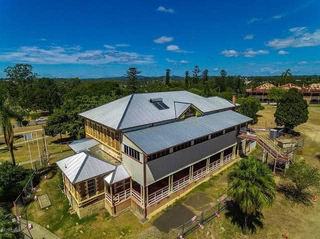

There Was Once an Asylum



This site not only provides an overview of mental health history and its implications for Goodna, but also explores the complex relationship between memory and history
There are stories we may never know, but this site uncovers the history, revealing the layers of understanding that form the foundation of the present.
It is done in a way that honours the patients, clients, and the people.
Bostock House & Garden
Built in 1885, extended 1901, c1924
Bostock House (former female patient ward 6) stands to the north of Anderson House, set back from and facing Ellerton Drive.
A purpose-built female ward building, it comprises its original symmetrical core, northeast extension (1901), southwest extension (1901, 1924, lavatory), and northwest verandah extension (c1924, later enclosed). The building retains its open, semi-formal garden setting. In 2020, the building accommodates offices and is highly intact. Fire stairs added (c1969) to the rear verandah and over the front verandah (since removed) are not of state-level cultural heritage significance.
Features of Bostock House, also of state-level cultural heritage significance, include:
• Form, scale, and materials: original two-storey core with a hip roof, projecting bay to front with a gable roof, one-storey projecting faceted bay to northeast (southwest bay demolished c1924), front verandahs with stop-chamfered timber posts and skillion roofs; one-storey extension to the northeast (1901) with hipped roof; one-storey extensions to the southwest with skillion (1901) and hip (c1924) roofs - both with lanterns; two-storey timber-framed verandah extension (c1924, later enclosed) to the northwest with skillion roof; roofs clad in corrugated metal; metal water goods; polychrome face brick walls with sandstone foundations; moulded concrete lintels and sills; timber floors throughout, with concrete floors in extensions and ground floor verandahs; plaster masonry partitions
• Layout: core comprising similar ground and first floor plans, with large open rooms along the southeast side (ground floor - day room and dormitory; first floor – dormitory); and individual patients' rooms along the northwest side flanking a central stairwell. The ground floor entry has a wide arched opening into the day room. Cast iron columns and a metal beam on the first floor indicate the original location of the dormitory/hallway wall (removed c1924). The northeast extension contains a kitchen, and the southwest wing contains a storeroom and toilets
• Details/ornamentation: polychrome brickwork with contrasting string courses (some in stone), frieze and quoins around openings; corbelled brick eaves brackets; louvred oculus; stop-chamfered timber posts to front verandahs
• Joinery: original and early timber-framed multi-paned windows; early metal-framed windows, awning windows with obscured glass (replaced c1950s); original and early timber panelled and glazed doors, some with fanlights; timber-framed multi-pane glazed partition between day room and dormitory, with obscured glass on lower windows; timber board linings to verandah and bathroom ceilings; early timber toilet partitions
• Details associated with patient management (security, safety, hygiene): patients' room doors with observation panes and fanlights
• stairwell location and configuration (recent timber stair fabric is not of state-level cultural heritage significance)
• Garden setting: spacious open lawns around the building, front lawn with mature fig; two mature cypress pines (callitris spp.) to the southwest; garden beds with stone edging; early concrete paths.
























